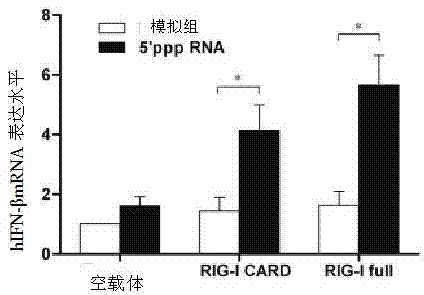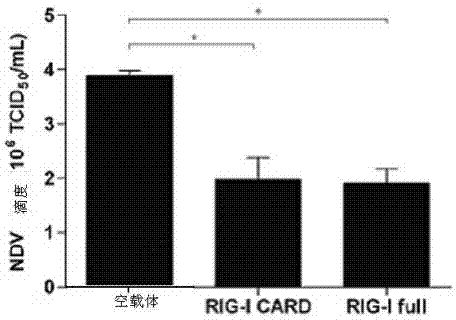Goose-origin gene RIG-I (retinoic acid-inducible gene-I) with anti-Newcastle disease virus activities and application thereof
An anti-Newcastle disease virus, gene technology, applied in antiviral agents, applications, gene therapy and other directions, can solve the problem of less research on antiviral immunity
- Summary
- Abstract
- Description
- Claims
- Application Information
AI Technical Summary
Problems solved by technology
Method used
Image
Examples
Embodiment 1
[0034] 1. Determination of goose RIG-I gene sequence and construction of eukaryotic expression plasmid
[0035] 1.1 Primer design
[0036] According to the existing RIG-I sequences of humans, ducks and zebra finches on GenBank, overlap PCR amplification primers P1, P2, P3, and P4 were designed to amplify the RIG-I gene of goose by fusion PCR, wherein P1, P2 is the upstream and downstream primers of the first round of PCR, and P3 and P4 are the upstream and downstream primers of the second round of PCR. After the two rounds of PCR products are mixed, P1 and P4 are used to perform the third round of PCR to obtain the whole field sequence. According to the conserved region, the identification primers P5, P6, and CARD region amplification primers P7, P8 were designed.
[0037] Table 1 Primer sequences used in RIG-I gene related PCR amplification
[0038] Primer sequence P1L 5′-CGGCCGGCAGAGCCCAGCC-3′ P2R 5′-GTCTTAGCAAAGAGAAGAGGTGCGAGTCTGTGGGTTATAGC-3′ ...
PUM
 Login to View More
Login to View More Abstract
Description
Claims
Application Information
 Login to View More
Login to View More - R&D
- Intellectual Property
- Life Sciences
- Materials
- Tech Scout
- Unparalleled Data Quality
- Higher Quality Content
- 60% Fewer Hallucinations
Browse by: Latest US Patents, China's latest patents, Technical Efficacy Thesaurus, Application Domain, Technology Topic, Popular Technical Reports.
© 2025 PatSnap. All rights reserved.Legal|Privacy policy|Modern Slavery Act Transparency Statement|Sitemap|About US| Contact US: help@patsnap.com



